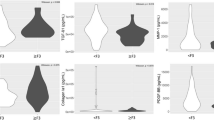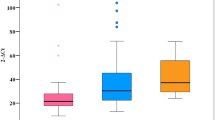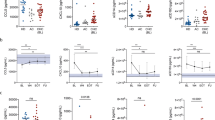Abstract
The IFNL3 genotype predicts the clearance of hepatitis C virus (HCV), spontaneously and with interferon (IFN)-based therapy. The responder genotype is associated with lower expression of interferon stimulated genes (ISGs) in liver biopsies from chronic hepatitis C patients. However, ISGs represent many interacting molecular pathways, and we hypothesised that the IFNL3 genotype may produce a characteristic pattern of ISG expression explaining the effect of genotype on viral clearance. For the first time, we identified an association between a cluster of ISGs, the metallothioneins (MTs) and IFNL3 genotype. Importantly, MTs were significantly upregulated (in contrast to most other ISGs) in HCV-infected liver biopsies of rs8099917 responders. An association between lower fibrosis scores and higher MT levels was demonstrated underlying clinical relevance of this association. As expected, overall ISGs were significantly downregulated in biopsies from subjects with the IFNL3 rs8099917 responder genotype (P=2.38 × 10−7). Peripheral blood analysis revealed paradoxical and not previously described findings with upregulation of ISGs seen in the responder genotype (P=1.00 × 10−4). The higher MT expression in responders may contribute to their improved viral clearance and MT-inducing agents may be useful adjuncts to therapy for HCV. Upregulation of immune cell ISGs in responders may also contribute to the IFNL3 genotype effect.
This is a preview of subscription content, access via your institution
Access options
Subscribe to this journal
Receive 6 digital issues and online access to articles
$119.00 per year
only $19.83 per issue
Buy this article
- Purchase on Springer Link
- Instant access to full article PDF
Prices may be subject to local taxes which are calculated during checkout




Similar content being viewed by others
References
National Institutes of Health Consensus Development Conference Statement: Management of hepatitis C 2002 (June 10-12, 2002). Gastroenterology 2002; 123: 2082–2099.
Hoofnagle JH . Course and outcome of hepatitis C. Hepatology 2002; 36: S21–S29.
Ge D, Fellay J, Thompson AJ, Simon JS, Shianna KV, Urban TJ et al. Genetic variation in IL28B predicts hepatitis C treatment-induced viral clearance. Nature 2009; 461: 399–401.
Suppiah V, Moldovan M, Ahlenstiel G, Berg T, Weltman M, Abate ML et al. IL28B is associated with response to chronic hepatitis C interferon-alpha and ribavirin therapy. Nat Genet 2009; 41: 1100–1104.
Tanaka Y, Nishida N, Sugiyama M, Kurosaki M, Matsuura K, Sakamoto N et al. Genome-wide association of IL28B with response to pegylated interferon-alpha and ribavirin therapy for chronic hepatitis C. Nat Genet 2009; 41: 1105–1109.
Asselah T, De Muynck S, Broet P, Masliah-Planchon J, Blanluet M, Bieche I et al. IL28B polymorphism is associated with treatment response in patients with genotype 4 chronic hepatitis C. J Hepatol 2012; 56: 527–532.
Kotenko SV, Gallagher G, Baurin VV, Lewis-Antes A, Shen M, Shah NK et al. IFN-lambdas mediate antiviral protection through a distinct class II cytokine receptor complex. Nat Immunol 2003; 4: 69–77.
Sheppard P, Kindsvogel W, Xu W, Henderson K, Schlutsmeyer S, Whitmore TE et al. IL-28, IL-29 and their class II cytokine receptor IL-28R. Nat Immunol 2003; 4: 63–68.
Marcello T, Grakoui A, Barba-Spaeth G, Machlin ES, Kotenko SV, MacDonald MR et al. Interferons alpha and lambda inhibit hepatitis C virus replication with distinct signal transduction and gene regulation kinetics. Gastroenterology 2006; 131: 1887–1898.
Asselah T, Bieche I, Narguet S, Sabbagh A, Laurendeau I, Ripault MP et al. Liver gene expression signature to predict response to pegylated interferon plus ribavirin combination therapy in patients with chronic hepatitis C. Gut 2008; 57: 516–524.
Sarasin-Filipowicz M, Oakeley EJ, Duong FH, Christen V, Terracciano L, Filipowicz W et al. Interferon signaling and treatment outcome in chronic hepatitis C. Proc Natl Acad Sci USA 2008; 105: 7034–7039.
Dill MT, Duong FH, Vogt JE, Bibert S, Bochud PY, Terracciano L et al. Interferon-induced gene expression is a stronger predictor of treatment response than IL28B genotype in patients with hepatitis C. Gastroenterology 2011; 140: 1021–1031.
Honda M, Sakai A, Yamashita T, Nakamoto Y, Mizukoshi E, Sakai Y et al. Hepatic ISG expression is associated with genetic variation in interleukin 28B and the outcome of IFN therapy for chronic hepatitis C. Gastroenterology 2010; 139: 499–509.
Urban TJ, Thompson AJ, Bradrick SS, Fellay J, Schuppan D, Cronin KD et al. IL28B genotype is associated with differential expression of intrahepatic interferon-stimulated genes in patients with chronic hepatitis C. Hepatology 2010; 52: 1888–1896.
Kohli A, Zhang X, Yang J, Russell RS, Donnelly RP, Sheikh F et al. Distinct and overlapping genomic profiles and antiviral effects of Interferon-lambda and -alpha on HCV-infected and noninfected hepatoma cells. J Viral Hepat 2012; 19: 843–853.
Witte K, Gruetz G, Volk HD, Looman AC, Asadullah K, Sterry W et al. Despite IFN-lambda receptor expression, blood immune cells, but not keratinocytes or melanocytes, have an impaired response to type III interferons: implications for therapeutic applications of these cytokines. Genes Immun 2009; 10: 702–714.
Moraga I, Harari D, Schreiber G, Uze G, Pellegrini S . Receptor density is key to the alpha2/beta interferon differential activities. Mol Cell Biol 2009; 29: 4778–4787.
Smith KR, Suppiah V, O'Connor K, Berg T, Weltman M, Abate ML et al. Identification of improved IL28B SNPs and haplotypes for prediction of drug response in treatment of hepatitis C using massively parallel sequencing in a cross-sectional European cohort. Genome Med 2011; 3: 57.
Fischer J, Bohm S, Scholz M, Muller T, Witt H, George J et al. Combined effects of different interleukin-28B gene variants on the outcome of dual combination therapy in chronic hepatitis C virus type 1 infection. Hepatology 2012; 55: 1700–1710.
Chen L, Borozan I, Sun J, Guindi M, Fischer S, Feld J et al. Cell-type specific gene expression signature in liver underlies response to interferon therapy in chronic hepatitis C infection. Gastroenterology 2010; 138: e1121–e1123.
McGilvray I, Feld JJ, Chen L, Pattullo V, Guindi M, Fischer S et al. Hepatic cell-type specific gene expression better predicts HCV treatment outcome than IL28B genotype. Gastroenterology 2012; 142: 1122–1131.
Naggie S, Osinusi A, Katsounas A, Lempicki R, Herrmann E, Thompson AJ et al. Dysregulation of innate immunity in hepatitis C virus genotype 1 IL28B-unfavorable genotype patients: impaired viral kinetics and therapeutic response. Hepatology 2012; 56: 444–454.
Thomas DL, Thio CL, Martin MP, Qi Y, Ge D, O'Huigin C et al. Genetic variation in IL28B and spontaneous clearance of hepatitis C virus. Nature 2009; 461: 798–801.
Cherian MG, Jayasurya A, Bay BH . Metallothioneins in human tumors and potential roles in carcinogenesis. Mutat Res 2003; 533: 201–209.
Friedman RL, Stark GR . Alpha-Interferon-induced transcription of HLA and metallothionein genes containing homologous upstream sequences. Nature 1985; 314: 637–639.
Varshney U, Jahroudi N, Foster R, Gedamu L . Structure, organization, and regulation of human metallothionein IF gene: differential and cell-type-specific expression in response to heavy metals and glucocorticoids. Mol Cell Biol 1986; 6: 26–37.
Schmidt CJ, Hamer DH . Cell specificity and an effect of ras on human metallothionein gene expression. Proc Natl Acad Sci USA 1986; 83: 3346–3350.
Takahashi S . Molecular functions of metallothionein and its role in hematological malignancies. J Hematol Oncol 2012; 5: 41.
Krizkova S, Ryvolova M, Hrabeta J, Adam V, Stiborova M, Eckschlager T et al. Metallothioneins and zinc in cancer diagnosis and therapy. Drug Metab Rev 2012; 44: 287–301.
Wu C, Pot C, Apetoh L, Thalhamer T, Zhu B, Murugaiyan G et al. Metallothioneins negatively regulate IL-27-induced type 1 regulatory T-cell differentiation. Proc Natl Acad Sci USA 2013; 110: 7802–7807.
Davis SR, Cousins RJ . Metallothionein expression in animals: a physiological perspective on function. J Nutr 2000; 130: 1085–1088.
Alter HJ, Seeff LB . Recovery, persistence, and sequelae in hepatitis C virus infection: a perspective on long-term outcome. Semin Liver Dis 2000; 20: 17–35.
Mao J, Yu H, Wang C, Sun L, Jiang W, Zhang P et al. Metallothionein MT1M is a tumor suppressor of human hepatocellular carcinomas. Carcinogenesis 2012; 33: 2568–2577.
Marusawa H, Hijikata M, Chiba T, Shimotohno K . Hepatitis C virus core protein inhibits Fas- and tumor necrosis factor alpha-mediated apoptosis via NF-kappaB activation. J Virol 1999; 73: 4713–4720.
Tai DI, Tsai SL, Chen YM, Chuang YL, Peng CY, Sheen IS et al. Activation of nuclear factor kappaB in hepatitis C virus infection: implications for pathogenesis and hepatocarcinogenesis. Hepatology 2000; 31: 656–664.
Girard S, Vossman E, Misek DE, Podevin P, Hanash S, Brechot C et al. Hepatitis C virus NS5A-regulated gene expression and signaling revealed via microarray and comparative promoter analyses. Hepatology 2004; 40: 708–718.
Agundez JA, Garcia-Martin E, Maestro ML, Cuenca F, Martinez C, Ortega L et al. Relation of IL28B gene polymorphism with biochemical and histological features in hepatitis C virus-induced liver disease. PloS One 2012; 7: e37998.
Bochud PY, Bibert S, Kutalik Z, Patin E, Guergnon J, Nalpas B et al. IL28B alleles associated with poor hepatitis C virus (HCV) clearance protect against inflammation and fibrosis in patients infected with non-1 HCV genotypes. Hepatology 2012; 55: 384–394.
Thompson AJ, Clark PJ, Zhu M, Zhu Q, Ge D, Sulkowski MS et al. Genome-wide association study identifies IL28B polymorphism to be associated with baseline ALT and hepatic necro-inflammatory activity in chronic hepatitis C patients enrolled in the IDEAL study. Hepatology 2010; 52: 1220A–1221A.
Yang CH, Murti A, Pfeffer SR, Basu L, Kim JG, Pfeffer LM . IFNalpha/beta promotes cell survival by activating NF-kappa B. Proc Natl Acad Sci USA 2000; 97: 13631–13636.
Carrera G, Paternain JL, Carrere N, Folch J, Courtade-Saidi M, Orfila C et al. Hepatic metallothionein in patients with chronic hepatitis C: relationship with severity of liver disease and response to treatment. Am J Gastroenterol 2003; 98: 1142–1149.
Nagamine T, Suzuki K, Kondo T, Nakazato K, Kakizaki S, Takagi H et al. Interferon-alpha-induced changes in metallothionein expression in liver biopsies from patients with chronic hepatitis C. Can J Gastroenterol 2005; 19: 481–486.
Nagamine T, Takagi H, Takayama H, Kojima A, Kakizaki S, Mori M et al. Preliminary study of combination therapy with interferon-alpha and zinc in chronic hepatitis C patients with genotype 1b. Biol Trace Elem Res 2000; 75: 53–63.
Takagi H, Nagamine T, Abe T, Takayama H, Sato K, Otsuka T et al. Zinc supplementation enhances the response to interferon therapy in patients with chronic hepatitis C. J Viral Hepat 2001; 8: 367–371.
Devitt E, Lawless MW, Sadlier D, Browne JA, Walsh C, Crowe J . Early viral and peripheral blood mononuclear cell responses to pegylated interferon and ribavirin treatment: the first 24 h. Eur J Gastroenterol Hepatol 2010; 22: 1211–1220.
Li X, Cai L, Feng W . Diabetes and metallothionein. Mini Rev Med Chem 2007; 7: 761–768.
Lansdown AB . Metallothioneins: potential therapeutic aids for wound healing in the skin. Wound Repair Regen 2002; 10: 130–132.
Pedersen MO, Larsen A, Stoltenberg M, Penkowa M . Cell death in the injured brain: roles of metallothioneins. Prog Histochem Cytochem 2009; 44: 1–27.
Aschner M, Cherian MG, Klaassen CD, Palmiter RD, Erickson JC, Bush AI . Metallothioneins in brain—the role in physiology and pathology. Toxicol Appl Pharmacol 1997; 142: 229–242.
Schoggins JW, Wilson SJ, Panis M, Murphy MY, Jones CT, Bieniasz P et al. A diverse range of gene products are effectors of the type I interferon antiviral response. Nature 2011; 472: 481–485.
Langmead B, Trapnell C, Pop M, Salzberg SL . Ultrafast and memory-efficient alignment of short DNA sequences to the human genome. Genome Biol 2009; 10: R25.
Ge D. http://compute1.lsrc.duke.edu/softwares/MetaP/metap.php . accessed: July 2013.
Anders S, Huber W . Differential expression analysis for sequence count data. Genome Biol 2010; 11: R106.
Acknowledgements
KSO was supported by an Australian National Health and Medical Research Scholarship. Work on this manuscript was in part supported by research grants from the National Health and Medical Research Council of Australia (APP1006759) and by an Australian ARC linkage grant (LP0990067). JG is supported by the Robert W Storr bequest to the Sydney Medical Foundation, University of Sydney. DRB is supported by the Hunt Family Senior Research Fellowship.
Author information
Authors and Affiliations
Corresponding author
Ethics declarations
Competing interests
The authors declare no conflict of interest.
Additional information
Supplementary Information accompanies this paper on Genes and Immunity website
Supplementary information
Rights and permissions
About this article
Cite this article
O'Connor, K., Parnell, G., Patrick, E. et al. Hepatic metallothionein expression in chronic hepatitis C virus infection is IFNL3 genotype-dependent. Genes Immun 15, 88–94 (2014). https://doi.org/10.1038/gene.2013.66
Received:
Revised:
Accepted:
Published:
Issue Date:
DOI: https://doi.org/10.1038/gene.2013.66



